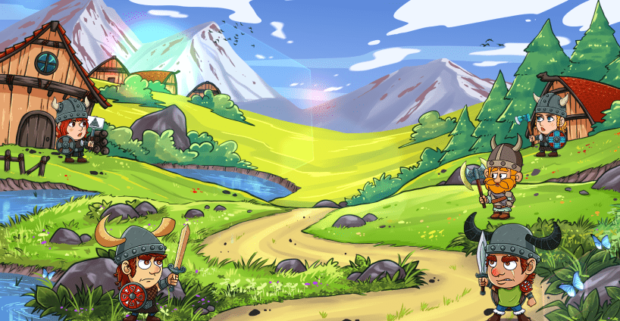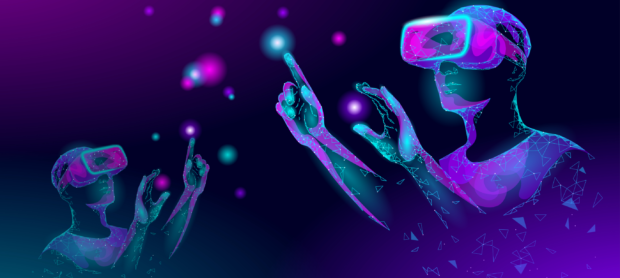As a developer, Software Development company owner, and IT enthusiast, I constantly study and analyze new trends and opportunities in development. My team and I have been developing AR/VR and Crypto apps and games for about four years. The announcement of the Metaverse gave a new breath for these areas of development. After analyzing new tendencies, essence Web3.0, and metaverse impact to various business spheres, I decided to compile them into this article and share my thoughts and conclusions with you.
Web 2.0: Main Concepts
The constantly evolving technological world, the improvement of systems, and the desire to achieve maximum independence on the InternetInternet have led to new concepts and notions. Beginning in 2005, the world gradually began to move to Web 2.0 Internet, the basic principles of which remain in place today. We cannot say a clear timeframe to say that Web 1.0 ended and Web 2.0 began. As well as to speak about Web 2.0 and Web 3.0. In fact, the world just started to develop technology and gradually change each industry. It is also essential to understand that the Internet technologically does not change dramatically, its essence remains the same. But its bandwidth and the speed of data transfer have changed.
What has changed in Web 2.0 – the availability of services with new functionality that users could use, with new features and levels of access. More advanced web resources and platforms began to appear. More technologically advanced, allowing a much larger set of interactions with them, and most importantly, were already interactive (users could write posts, leave comments, etc., add different pieces of information from themselves for other users, etc.). Web 2.0 appeared more advanced and developed scheme of monetization of users’ data and attention. But all the income from advertising receives the service itself, where advertising is placed.
Also, a key feature of Web 2.0 is to store data on the Internet. All data is stored centrally on massive servers, and all data users put out belongs to the service on its servers. Accordingly, if any service disconnects them, the user will lose all the data. I conclude that Web 2.0 is centralized, limiting users’ freedom of expression, and these restrictions definitely limit the quality of content in general. Another weakness of Web 2.0 is the security of sensitive data. More than half of online services require users to provide personal data, such as identification data (security number, passport, driver’s license), payment details, location, device fingerprint. In fact, personal data is stored on content sites, and this data can be hacked, compromised, or even sold.
Web 2.0 Vs. Web 3.0: New Approaches In Internet World
Let’s move on to the topic of the Web 3.0 Internet. What exactly is the difference between Web 3.0 and the Web 2.0 Internet, and what are the reasons for its emergence. Now we are at the same stage as in 2004-2006, where we were gradually moving from Web 1.0 to Web 2.0. Now applications of the new Internet are gradually emerging, and they can already be used, just most of the world does not know about it yet and does not use it. Web 3.0 is different from Web 2.0 – it’s how data is stored. All information is now stored on the blockchain and takes advantage of it. The bottom line is that all data is stored decentralized, and the only owner of your data is yourself, and no one else has access to it but you. This gives a kind of freedom for users to post content and so on. In Web 3.0 user will be the beneficiary of his data because it will not be stored on servers but directly on the blockchain. This means that the user will benefit from specific actions with personal data.
Another vital characteristic of Web 3.0, if we take the payment sector as an example of bitcoin, is that users can now make decentralized payments, that is, payments without intermediaries – P2P – no censorship, and the users can manage the property as they like. In general, everything that concerns the sphere of blockchain and cryptocurrency is already Web 3.0 Internet; just not all users have come to this and begun to use it. Moreover, with the development of Web 3.0, the hype on it grows with great speed (just as it was with the development of dotcom Web 2.0), and that would get the first benefits or profit it, you need to start now to pop into this area and become a pioneer here.
Metaverse Is One Of The Related Parts Of Web 3.0
With the opportunities that bring the Web 3.0, new variants of social networks, games, and other platforms that allow users to be even more immersed in the virtual world have begun and continue to evolve. Now you can see the rapid development of NFT games, social networks like Decentralend, more and more opportunities to buy cryptocurrency, NFT tokens, etc. So this is what a metauniverse is?
Metaverse is a virtual world we can connect via the Internet, create avatars, buy some assets or exchange for internal currency, cooperate with other virtual people or services, explore new territories, etc. Today the meta world is mainly focused on gaming platforms, but other variants will appear, such as workspaces, social networks, investment tools, festivals, events, etc. It could work as a mix of software, immersive virtual world hardware, data centers, and blockchain technology. In other words, the metauniverse is like a hybrid of social media, entertainment, work, and personal life.
One another way for accessing the meta world is virtual or augmented reality. You don’t need to type on the keyboard and look into the monitor, you can be transported to the meta-universe through a virtual reality helmet or smart glasses, and motion tracking devices will allow you to move freely in this space. It will even be possible to interact with other people and objects. This world will operate using blockchain technology, protecting against fraud and other security threats. Users will make money transactions and transact using cryptocurrencies such as bitcoin (BTC) or ether (ETH).
As the meta-universe develops, users will become more and more immersed in the virtual space, which will create a kind of economy within this world. Experts say that the metauniverse can become a tool or part of an inclusive economy (Its goal is to provide equal access to economic independence and unhindered interaction between social groups). In this virtual world, users will create businesses that will generate income for their owners. For example, it can be games, or a rental business, the extraction of specific resources and their sale, skins, or other assets.
Businesses and companies will be able to sell their goods and services through the Metaverse. This gives it enormous potential for development and rapid growth. For example, Nike hires a whole staff of employees to design clothes for the gaming space. And Louis Vuitton has a contract with Riot Games to create skins. With a well-developed metauniverse, we could freely transcend cultural barriers, differences between countries, entire nations, and even the laws of physics. The meta world would be helpful for just about everything, from work and games to mundane things like going to the doctor or preparing for exams. By the way, my company Puls actually started from AR/VR development 4 years ago, so I’m happy to see a new massive hype and demand on these incredibly helpful technologies.
Products Examples On The Market
You learned about Web3 and meta. Let’s find out the most popular products we can already find on the Internet. An excellent example of a meta-universe is Bloktopia, a virtual skyscraper filled with various features that allow platform users to learn and earn in different ways. In this polygonal virtual reality meta virtual universe, participants will be transported into an immersive virtual world, allowing them to buy, sell and rent virtual real estate and generate more revenue streams such as games, token placement, and advertising revenue.
In addition, they can also attend virtual events, galleries, stores and have direct access to educational and training tools from significant figures in the crypto world. The skyscraper has 21 levels corresponding to a supply limit of 21 million bitcoins, and each level has unique features and functions designed to enhance each user’s experience.
Play2Earn games with NFT at their core are now developing on par with crypto art, and users are spending millions of dollars on in-game purchases. As of the end of August 2021, the total amount of transactions in NFT games for the month was more than $820 million. The main feature of crypto games is NFT objects, with which users can earn cryptocurrency and, therefore, real money. Examples: Axie Infinity, Waves Ducks, Gods Unchained, Alien Worlds, Battle Racers
Now it is hard to evaluate the perspective of the NFT games market, but one thing is clear – it is growing exponentially and is changing the entire gaming industry in a short period. According to a report by NonFungible.com, token sales rose to $2 billion in the first quarter of 2021. The growing popularity of NFTs is also contributing to this trend. People actively invest in unique digital goods, increasing mass audiences’ confidence in the format. If ten years ago it was hard to imagine that investing in pixels could become a profitable business, today things are moving toward the point where virtual objects will have the same value as items in the real world.
NFT marketplaces – The NFT marketplace combines the functions of an online store, an auction, and a blockchain platform for issuing non-interchangeable tokens. Users should be able to create their NFT items and sell them. Examples: OpenSea, Foundation, Decentraland, Playdapp marketplace, Raible, Binance NFT. The popularity of NFT tokens is increasing all the time, precisely as the popularity of places, i.e., marketplaces, for their purchase-sale is growing. The idea of the Metaverse has enormous potential. An ideal application of this concept would allow users to experience almost any activity, so it could potentially be used for nearly anything. For example:
Educational applications. Developments are already underway for educational use. One of the intentions is to provide a more intense and immersive way to conduct field trips anywhere in the world and history.
The realm of real estate and development. If you’ve ever participated in a virtual home tour, imagine a version of the Metaverse with 3D immersive, realistic virtual home tours. It would open up the world to people wanting to live in other countries and a new market for real estate agents and brokers worldwide.
Business applications. We can’t forget that brick-and-mortar businesses can also play a role in the Metaverse. A virtual environment that simulates their actual stores and offices is one application.
Another way Metaverse uses it is to improve the shopping experience for its customers. 3-D virtual shopping improves what the Internet and online stores offer today.
Our Experience
And here are some of the solutions in this area that we’ve worked with recently:
- Animar. Educational game with Augmented Reality mode, including the elements of Tamagochi and real wild animals.
- Vikingschain. The legendary multiplayer battle game allows users to train heroes and win rewards in tournaments, utilizing the BSC technology.
- Labster. Virtual labs – Virtual lab simulations allow students to complete laboratory experiments online and explore abstract concepts and complex theories without stepping into a physical science lab.
- Steelcase Spaces AR Catalog – app for viewing furniture made by Steelcase company
- Job WalkAR – Application for a team of builders to manage team collaboration using roles, group projects, tasks systems, chats, etc. One of the cool features was setting tasks by creating GPS AR Flags and viewing them.
- MODY – AR Furniture shop.
- Cooking Lessons in AR – App for watching step-by-step cooking lessons in Augmented Reality

Facts And Figures Of The Meta-Universe
Games, AR, VR, create a primary market of $413 billion.
According to the analysis, the primary revenue opportunity in the Metaverse for video game makers consists mainly of the existing market for gaming software and services and growing sales of gaming hardware. Within this primary market, which could reach $412.9 billion in 2024, up from $274.9 billion in 2020, software and services revenue and in-game advertising revenue account for about 70% of the total market. Although this is an existing market for online game makers, those who manage to gain a larger share of users and engagement by translating existing games into virtual worlds will gain a larger share of sales in this sector. Gaming hardware, including gaming PCs and peripherals and AR/VR equipment such as Facebook’s Oculus, make up the remainder of the primary market opportunity.
Live events, social advertising will increase the market.
The ability to bring live events such as concerts, film screenings, and sporting events into virtual 3D worlds presents additional opportunities for game makers as they get online experiences into social 3D worlds to take advantage of the Metaverse. Game makers, including Epic Games and Roblox, are already running concerts in their games, and Unity is investing in opportunities to incorporate sports content and tools into its 3D development kit. Revenues from the live entertainment business that could be part of the Metaverse concept – movies, live music, and sports – could exceed $200 billion in 2024, roughly the same level as 2019, as the business slowly recovers from the Covid-19 pandemic, according to PWC, Statista and Two Circles.
Conclusion
The Metaverse, like all other forms of technology, will have good and bad applications and intentions because of the potential change in how we shop, do business, date, have fun, play games, make money, trade in the marketplace, etc. The whole idea of the Metaverse could change the entire culture of the world as a whole. But it’s going to happen regardless of how people feel about it. We try to treat it like any other technological innovation. It can be used for good, so it has potential. Now I have learned what the Metaworld is, how it plans to work, its applications, and its problems. What will come out of it remains to be seen. You can make your own decision.





